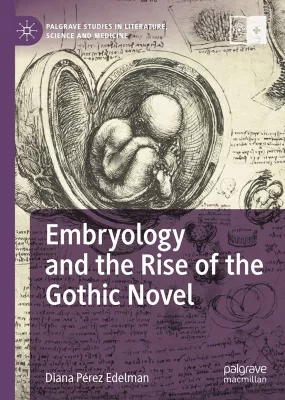Published

Diana Pérez Edelman. Embryology and the Rise of the Gothic Novel. Palgrave Studies in Literature, Science, and Medicine. Series eds. Sharon Ruston, Alice Jenkins, and Jessica Howell. Cham CH: Palgrave Macmillan/Springer Nature, 2021. Pp. xii + 180. $119.99. ISBN 978-3-030-73647-7.
The Gothic is deeply concerned with the relationships between the present and the past and with family histories. Robert Mighall has argued that the Gothic inhabits ‘the historical past’ or else ‘identifies ‘pastness’ in the present, honing in on struggles ‘to exorcise the ghosts of the past’; struggles often complicated or stymied by problematic inheritances capable of destroying otherwise ‘respectable families.’1
Related event
“Nothing is created ex nihilo,” Mary Shelley famously remarked in her introduction to the 1831 third edition of Frankenstein. From what, then, do monsters and stories derive? A mode of storytelling that foregrounds these types of questions must also have some interest in the biological relations between generations. As Diana Pérez Edelman proposes, the Romantic-era Gothic is concerned with the science of prenatal human development. Edelman “explores the relevance of the sciences of germination in the Gothic novel” and finds that “When read through the sciences of generation, the Gothic emerges, ironically, as scientifically progressive and an aesthetic success in its proliferation of genres;” it also constantly explores the origins and development of storytelling, art, and cultural memory (2-3).
In eighteenth-century Europe, including Britain and Ireland, two competing theories of human generation—what we now call embryology—waged war in science media and the broader public sphere: preformationism and epigenesis. Edelman explains both theories in accessible language. Preformationism contends that the human being is fully formed at conception, imbued with spirit by God, and must simply grow during pregnancy. Ovist preformationism insisted that all matter and characteristics derive from the ovum (egg); spermist preformationism argues the opposite, while epigenesis is the antithesis of preformationism: a theory that renders reproduction mechanical, anarchic, and multivariate—and which turned out to be correct. “The Gothic is the quintessentially epigenetic genre,” Edelman contends, “for it foregrounds biological and aesthetic origins and privileges internal passion, as opposed to parental control, as the source of identity, both for its characters and the genre itself” (37).
To demonstrate this, Edelman introduces the Gothic preoccupation with preformationist versus epigenetic theories of generation by close-reading a letter and a poem by a young Horace Walpole, showing his application of embryological discourse to questions of aesthetic creation. The second chapter shows Walpole’s The Castle of Otranto depicting “conflict between mechanics, external origins and organic, internal ones” (47) and showing that parenthood “based on preformationist ideas—wealth, status, lust—cannot be sanctioned” (56). As Gothic grows up, it replicates this conclusion. Ann Radcliffe was related to the anatomist William Chessenden. Informed by Chessenden, Radcliffe incorporates embryology into romances that prove stridently on the side of epigenesis (71).
Another Gothic foremother, Mary Shelley, explores “the ineluctable connection between aesthetic and biological life” (89). Shelley pits the two theories of generation against each other, showing that Victor Frankenstein’s beloved alchemical inspirations can be read as early proponents of epigenesis and/or “female centered theories of generation” while various events in the novel operate as proof that “preformation produces only machines, not autonomous subjects,” while epigenesis fosters self-fashioning and agency (91).
Finally, Edelman points out the parallels between the novel and its 1831 introduction’s depictions of biological and aesthetic creation (114). I wondered about additional generative imagery, such as the crucial role played in the destruction of Justine by a miniature portrait, alluring to Victor Frankenstein, whose geographical movements might suggest an attempt to hide a pregnancy.
The final two chapters respectively explore preformationist and epigenetic imagery in Charles Maturin’s Melmoth the Wanderer (1820) and in James Hogg’s extremely weird, uncomfortably comic, and deeply uncanny Confessions of a Justified Sinner. Maturin’s Biddy Branigan “births” the novel, but an unresolvable “search for origins … leads to unending” and unreliable narration (152-3). Nothing, neither humans nor stories, has a unitary origin. In 1824, James Hogg’s satirical, playful Gothic novel The Private Memoirs and Confessions of a Justified Sinner pits preformationist and epigenetic processes and imagery against each other as antihero Robert Wringhim Colwan, sometime Laird of Dalcastle, gestates his memoir and tries to figure out who he is and what his origins are.
In a coda, Edelman proposes that anxieties about theories of generation even inform modern Gothic classics such as Roman Polanski’s 1968 film Rosemary’s Baby. Another example might be the obscure 1983 novel The First Born. This second-wave feminist adaptation of Frankenstein enlists Gothic imagery to show how denial of reproductive choice can destroy women, families, and society. It was written by Caroline Thompson, screenwriter of the more enduring Gothic satire Edward Scissorhands (1991), which begins and ends with preformationist acts of male creation and features a mob terrified by the idea that humans might, in various ways, be living machines. Edelman’s monograph opens up many fruitful avenues of exploration in the Gothic tradition; additional scholars should explore them.
1. Robert Mighall, A Geography of Victorian Gothic Fiction: Mapping History’s Nightmares (Oxford: Oxford University Press, 1999), p. xiv, p. 78.
